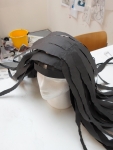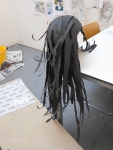With my garment complete, it was time to install the work!
Before installing work we were asked to write an artist proposal; this is what all artists must complete when wanting to exhibit work in a gallery so it was good practice and ensures that you get that best possible place for your work to look professional and sleek when fully installed.
Within my art proposal I stated that I wanted my work hung and that I needed enough space for six plaster cast hands to be evenly spread when attached to the wall. The space also needed to be big enough for an audience to be able to gather in order to be able to watch my performance.
Although the installation of work can be quite tedious it’s great to have it completed and for the work to be shown in the best possible way. I began by asking for help from the technician, driftwood was attached to the wall at approximately a 45 degree angle, so that the garment could hang but not against the wall and could still be clearly viewed by the audience. As well as the garment I also hung a mannequin leg within the garment, this was to communicate the idea of metamorphosis and the moment the Little Mermaid is gaining human legs. Both the leg and the garment had strips of dyed aqua film attached and wrapped around them as to achieve a fleshy look and to add texture.
After this was completed the cast hands were attached to the wall with approximately 40cm between each hand and then the black wigs where hung on the hands.
These are some photos of the progression of the installation, final images of the installation coming soon:
























